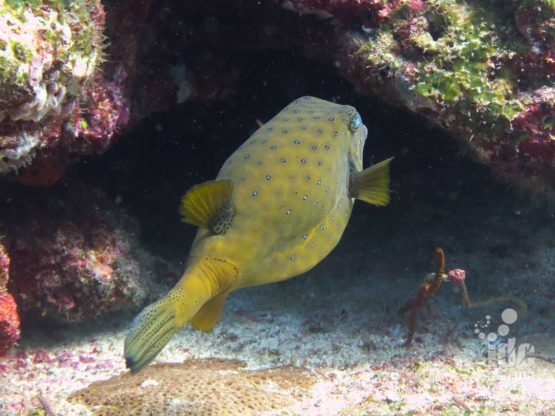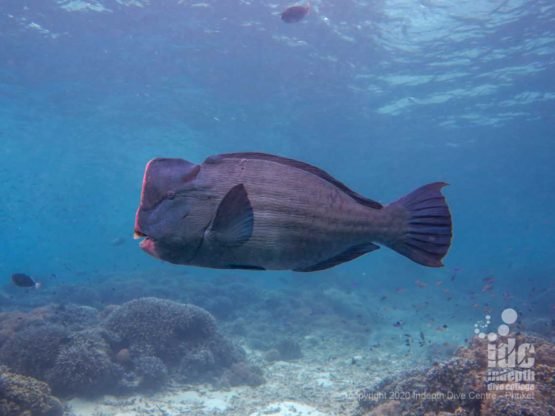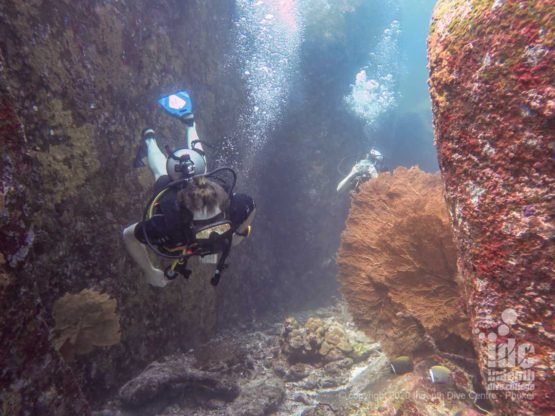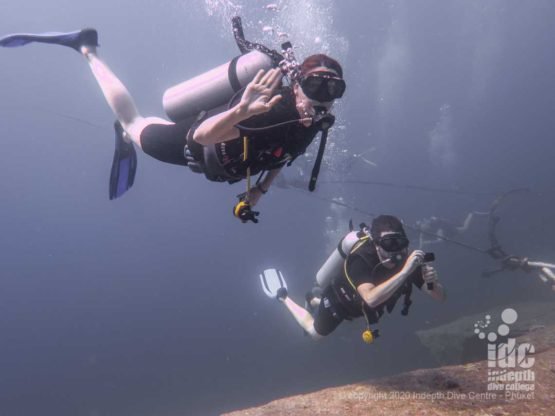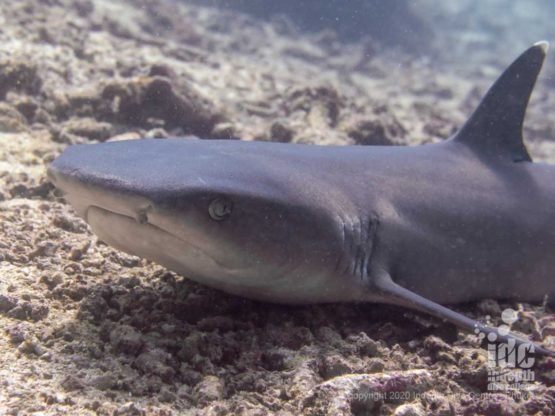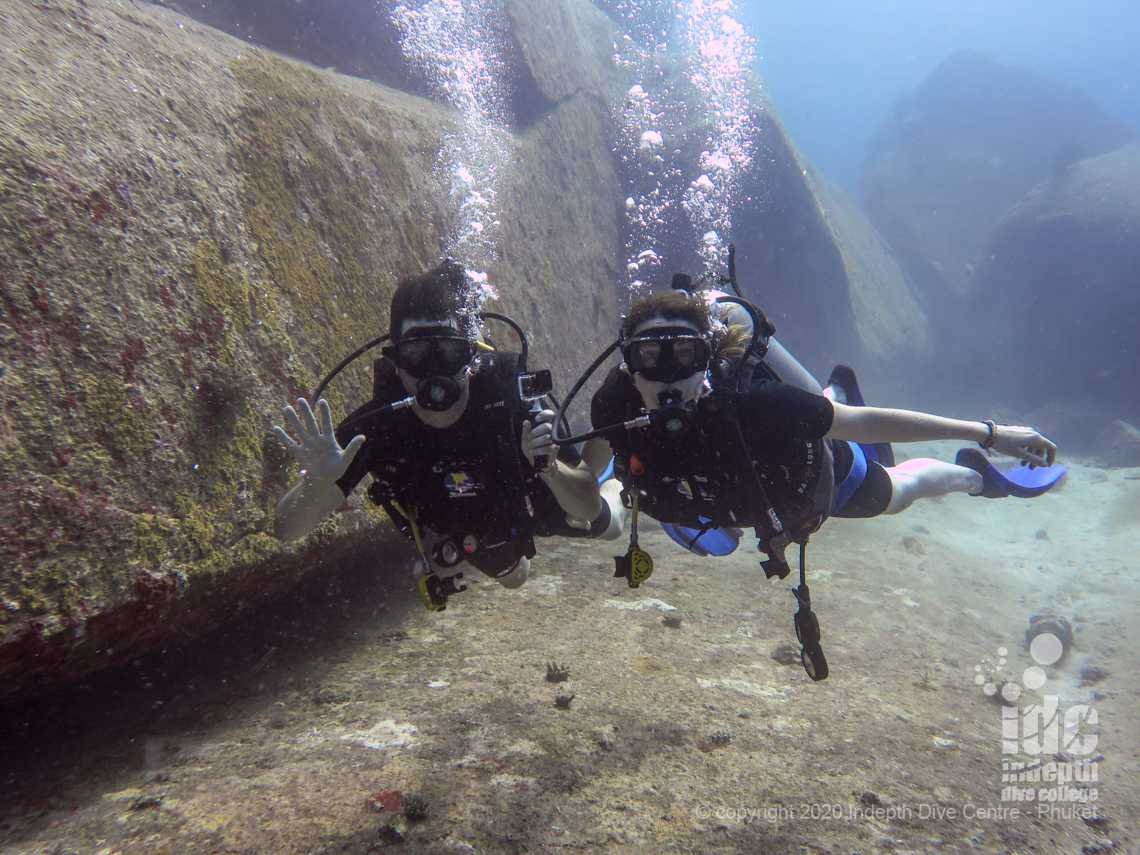
Similan Islands No. 3: Sharkfin Reef / Hin Phae
Sharkfin Reef or Hin Phae in Thai, begins one mile South East of Island No. 3 and actually encompasses two quite different sites. These are Shark Fin Reef and Boulder City which are at each end of the reef. Normally three pinnacles can be seen from the surface, and it is from these rocks and the way they breaks the surface that, yes you guessed it, this awesome scuba diving dive site gets its name!
Huge boulders that drop off steeply to 35-40+m and are surrounded by sand occupy the vast majority of the site. With many of the boulders having stacked themselves on top of one another over the centuries forming many swim-throughs. As long as these are dived with caution, they provide a great dive site that divers can enjoy. Additionally there are two large coral reefs that can be divided into Northern and Southern areas.
The Northern area has more corals consisting mostly of hard corals like Staghorn Coral and soft corals with a scattering of rocks and sea fans. What interesting is that this is in contrast to the Southern side which is made up primarily of stunning sheer vertical walls and drop offs!


Making the most of Sharkfin Reef / Hin Phae Similan Island No. 3
Sharkfin Reef is collection of the signature granite boulders which make up parts of The Similans and are mainly submerged. However, at low tide 3 pinnacles break the surface which give the dive site its name. However at high tide these cannot really be seen.
The main granite boulder of Sharkfin Reef is between 40-60m across, with a collection of smaller boulders scattered around. Currently, there are two mooring lines which can be used for descent, but it is not normally required. This is because the main boulders can be used for protection from the current which runs from North to South. Or when the current is running South to North. However, this can be quite hard to predict on this Similan Islands dive site. Consequently we have Tide Tables, but even then, it’s often doing the opposite of what it should. Sharkfin Reef is however a very large dive site, and jumping somewhere in the middle is always a good option.
The Northern side of Sharkfin Reef is the “shallow” side away from the main granite boulder. This is usually 15-20m and there are number of large fields of hard corals to be found here, particularly Staghorn. Similar the Stag Horn Corals you will see if you dive Phuket.
By comparison, the Southern side is much deeper and drops off to between 25-30m fairly quickly. Pay attention, as if you continue swimming away from the main site in a Southerly direction, it reaches a depth of approximately 40m. Again, patches of hard coral to be found here, along with some very large Gorgonian Sea Fans. In fact, these can be found throughout the Southern side.
How to Navigate on Sharkfin Reef:
For Sharkfin Reef there is no specific recommended starting point. If you start on the Southern (deep) side you can cross the main granite rock. This way you can then finish on the Northern (shallow) side, as the main rock can be crossed at various parts as is at a depth of between 5- 8m.
So if you are starting on the Southern side, then it is worth swimming away from Sharkfin Reef main site across the sand. As here you can expect to find Garden Eels, Blue Spotted and Kuhl’s Stingrays. Additionally, there are many species of Gobies, including the Red Fire Goby. Also, you can normally spot one of the resident Hawksbill Turtles. And keep an eye out for Octopus and there are a few spots where you can find the rare Tomato Anemone Fish.
And in the deeper waters you may also see Leopard Sharks sitting on the sand!
Remember that during the daytime Leopard Sharks are normally sleeping, as they are nocturnal hunters. Although if approached from the front or side, you can get very close for a great photograph. However be warned that if you come in from behind them or on top they will sense you and swim off. Therefore, please do try to avoid doing this whenever possible.
And if you are very lucky, there’s always a chance of Guitar Sharks.
Remember to always keep an eye out into the blue for Manta Rays & Whale sharks, especially in March and April.
Is Sharkfin Reef a good Similans Dive Site for Rebreather Diving?
Rebreather divers seem to have different experiences with Leopard Sharks. We put this down to the lack of bubbles and the usual noises they associate with scuba divers being missing. Thus Leopard Sharks seem almost confused as we are large enough to be something they should know about, yet they don’t. We have spent many, many dives lying next to these awesome creatures on the sand or swimming gently along with them. Additionally, if you look carefully, you can also spot White Tip Reef sharks here.
There are other smaller granite boulders to be found away from the main site on the Southern side. With the top of these being around 25m and with visibility normally 30m+. However, if you cannot see the main rock when you want to swim back, then just head North.
Sharkfin Reef is an excellent Similans Dive Site for mid-water activity. Thus, you can expect to see Giant and Blue Fin Trevally and Dogtooth Tuna. There are also lots of schooling Chevron & Giant Barracuda and some very large Surgeon/Unicorn Fish.
And if you get the chance to do this as a Sunset Dive, the midwater activity is truly amazing!
Do the Similan Islands have Napoleon Wrasse and Bumphead / Humphead) Parrot Fish?
Yes they do is the simple answer! You can see very large Napoleon Wrasse and Bumphead / Humphead) Parrot Fish. And this is one of ONLY TWO Similan sites, along with Boulder City, where Bumphead Parrot Fish can be sighted. These fish can get up to 1.5m long if you are lucky enough to spot one. Though for some reason, along with Napoleon Wrasse, they are very shy in the Similans. So remember to keep your eyes open as you may see them only for a few seconds before they disappear
And if you do not own an underwater camera, then yes, you will be cursing. The good news however, is that your Dive Guide will be able to take photos for you. However you might want to take this awesome opportunity to take your PADI Digital Underwater Photography Specialty Diver Course. After all you couldn’t ask for a more perfect environment than a Similans Liveaboard Safari for a PADI Underwater Photo Course. Not only do you have breath-taking visibility and marine life, but you also have all the time in world to download and edit photos. This way you will get plenty of feedback on how to improve your underwater photos.
Ending the dive
When you are looking to end the dive, cross the main granite boulder and end the dive on the opposite side. This is because most parts are between 5-8m and therefore quite shallow. However, if the current is strong you can literally be blown across the top of the boulder. In this case just be careful and watch your buoyancy.
Remember to swim away from the rocks during your safety stop as it's easier for the dive boat to pick you up.
Sharkfin Reef is an excellent dive site and can be dived any time of the day. In addition to a great Sunset Dive as the main rock is fairly shallow ...






